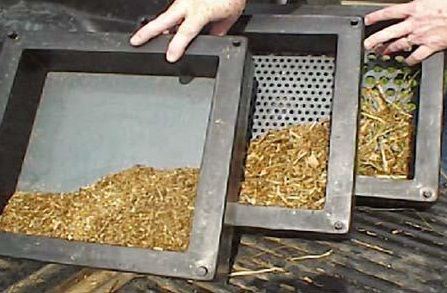When creating balanced diets for cattle, one faces many difficulties, one is looking for optimal solutions. But all these solutions may not work if these rations are not brought to the cows. The reason may be low management (a good person, but with a hangover) in the distribution and preparation of feed, as well as the correct size of the particles of the feed mixture.
The particle size has a great effect on the cow, for example, a sufficient length of course feed is necessary for the proper operation of the scar. Acidosis, laminitis - the most common problems for the industrial production of milk, while not following the structure of the feed.
Proceeding from this, it is necessary to be absolutely sure that the cow does not have the opportunity to choose the ingredients of the feed from the prepared feed mixture throughout lactation, it is very important for the correct operation of the scar.
To do this, one must be able to correctly measure the size of the particles of feed properly. Such data are very important for the formulation of the optimal feed mix. Management (control) of the size of feed particles begins with the harvesting of feed in the optimal stage of maturity (ripeness).
Proper grinding of feed ingredients helps to achieve optimum particle sizes in the feed mix. In addition to directly measuring the size of the feed particles, it is also necessary to analyze the results obtained.
Pennsylvania ScreenA simple and effective way to measure the results of preparing feeds for feeding. The feed mixture begins to "work" when it is properly prepared (cut) by a mixer. Analysis using this tool will help to understand the state of the feed mix that the cow consumes, prevent selective intake of feed and thereby prevent problems, for example, with metabolism or productivity.
Pennsylvania sieve consists of 3 or 4 boxes, which have different holes size. The upper box cuts off particles of more than 1.9 cm, the middlebox holds 0.8 cm particles, and particles smaller than 0.8 cm fall into the lower box. This method of analysis allows us to quickly understand the structure of the feed mixture.
To start using, collect the screen in the correct order. The upper box is the largest holes, then the box with a smaller diameter and the last box without holes.

Pennsylvania sieve
Put 300-400 gr. Sample feed in the upper box. A sample of food should be taken in several places from the feed table. Shake the Pennsylvania strainer 5-6 times and turn by a quarter. When shaking, there should be no vertical movements. This process must be repeated seven times, in total 40-45 shakes.
Measurements should be done several times a day - after 4, 8, 12 and 24 hours after feeding.
Table 1. Evaluation of the quality of the diet
| Sieve | Diameter of the hole, mm | The size of the delayed particles | Recommended percentage in feed mixes |
|---|---|---|---|
| Top Sieve | 19.0 mm | More than 19 mm | 2 - 8 % |
| Medium sieve | 8.0 mm | 8 to 19 mm | 30 - 50 % |
| Bottom sieve | 1.3 mm | 1.3 to 8 mm | 30 - 50 % |
| Pallet | - | Less than 1.3 mm | Less than 20% |
Source: Assessment of the feeding ration of the Kyrgyz Republic




